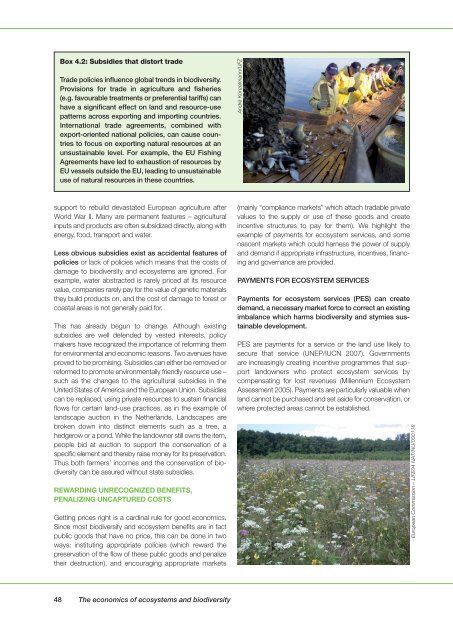Interim Report - TEEB
Interim Report - TEEB
Interim Report - TEEB
Create successful ePaper yourself
Turn your PDF publications into a flip-book with our unique Google optimized e-Paper software.
Box 4.2: Subsidies that distort trade<br />
Trade policies influence global trends in biodiversity.<br />
Provisions for trade in agriculture and fisheries<br />
(e.g. favourable treatments or preferential tariffs) can<br />
have a significant effect on land and resource-use<br />
patterns across exporting and importing countries.<br />
International trade agreements, combined with<br />
export-oriented national policies, can cause countries<br />
to focus on exporting natural resources at an<br />
unsustainable level. For example, the EU Fishing<br />
Agreements have led to exhaustion of resources by<br />
EU vessels outside the EU, leading to unsustainable<br />
use of natural resources in these countries.<br />
André Künzelmann/UFZ<br />
support to rebuild devastated European agriculture after<br />
World War II. Many are permanent features – agricultural<br />
inputs and products are often subsidized directly, along with<br />
energy, food, transport and water.<br />
Less obvious subsidies exist as accidental features of<br />
policies or lack of policies which means that the costs of<br />
damage to biodiversity and ecosystems are ignored. For<br />
example, water abstracted is rarely priced at its resource<br />
value, companies rarely pay for the value of genetic materials<br />
they build products on, and the cost of damage to forest or<br />
coastal areas is not generally paid for.<br />
This has already begun to change. Although existing<br />
subsidies are well defended by vested interests, policy<br />
makers have recognized the importance of reforming them<br />
for environmental and economic reasons. Two avenues have<br />
proved to be promising. Subsidies can either be removed or<br />
reformed to promote environmentally friendly resource use –<br />
such as the changes to the agricultural subsidies in the<br />
United States of America and the European Union. Subsidies<br />
can be replaced, using private resources to sustain financial<br />
flows for certain land-use practices, as in the example of<br />
landscape auction in the Netherlands. Landscapes are<br />
broken down into distinct elements such as a tree, a<br />
hedgerow or a pond. While the landowner still owns the item,<br />
people bid at auction to support the conservation of a<br />
specific element and thereby raise money for its preservation.<br />
Thus both farmers’ incomes and the conservation of biodiversity<br />
can be assured without state subsidies.<br />
REWARDING UNRECOGNIZED BENEFITS,<br />
PENALIZING UNCAPTURED COSTS<br />
Getting prices right is a cardinal rule for good economics.<br />
Since most biodiversity and ecosystem benefits are in fact<br />
public goods that have no price, this can be done in two<br />
ways: instituting appropriate policies (which reward the<br />
preservation of the flow of these public goods and penalize<br />
their destruction), and encouraging appropriate markets<br />
(mainly “compliance markets” which attach tradable private<br />
values to the supply or use of these goods and create<br />
incentive structures to pay for them). We highlight the<br />
example of payments for ecosystem services, and some<br />
nascent markets which could harness the power of supply<br />
and demand if appropriate infrastructure, incentives, financing<br />
and governance are provided.<br />
PAYMENTS FOR ECOSYSTEM SERVICES<br />
Payments for ecosystem services (PES) can create<br />
demand, a necessary market force to correct an existing<br />
imbalance which harms biodiversity and stymies sustainable<br />
development.<br />
PES are payments for a service or the land use likely to<br />
secure that service (UNEP/IUCN 2007). Governments<br />
are increasingly creating incentive programmes that support<br />
landowners who protect ecosystem services by<br />
compensating for lost revenues (Millennium Ecosystem<br />
Assessment 2005). Payments are particularly valuable when<br />
land cannot be purchased and set aside for conservation, or<br />
where protected areas cannot be established.<br />
European Commission – LIFE04 NAT/HU/000118<br />
48 The economics of ecosystems and biodiversity

















